Samsung Electronics Co SPHM620 Cellular/PCS CDMA Phone with Bluetooth User Manual C s and Settings ADMI
Samsung Electronics Co Ltd Cellular/PCS CDMA Phone with Bluetooth C s and Settings ADMI
Users Manual

* Depending on the software installed or your service provider or country,
some of the descriptions in this guide may not match your phone exactly.
* Depending on your country, your phone and accessories may appear
different from the illustrations in this guide.
World Wide Web
http://www.samsungmobile.com
M620.book Page 1 Friday, December 1, 2006 12:57 PM
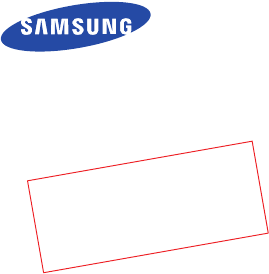
Approval
2006. 12. 1
SPH-M620
User’s Guide
M620.book Page 2 Friday, December 1, 2006 12:57 PM
Intellectual Property
All Intellectual Property, as defined below, owned by or
which is otherwise the property of Samsung or its
respective suppliers relating to the SAMSUNG Phone,
including but not limited to, accessories, parts, or
software relating there to (the “Phone System”), is
proprietary to Samsung and protected under federal
laws, state laws, and international treaty provisions.
Intellectual Property includes, but is not limited to,
inventions (patentable or unpatentable), patents,
trade secrets, copyrights, software, computer
programs, and related documentation and other works
of authorship. You may not infringe or otherwise
violate the rights secured by the Intellectual Property.
Moreover, you agree that you will not (and will not
attempt to) modify, prepare derivative works of,
reverse engineer, decompile, disassemble, or
otherwise attempt to create source code from the
software. No title to or ownership in the Intellectual
Property is transferred to you. All applicable rights of
the Intellectual Property shall remain with SAMSUNG
and its suppliers.
Samsung Telecommunications America (STA),
Inc.
Headquarters:
1301 East Lookout Drive Suite 150 Richardson,
TX 75082
Internet Address: http://www.samsungusa.com
©2006 Samsung Telecommunications America, Inc. is
a registered trademark of Samsung Electronics
America, Inc. and its related entities.
Openwave® is a registered Trademark of Openwave,
Inc. RSA® is a registered TrademarSk RSA Security,
Inc.
M620.book Page 3 Friday, December 1, 2006 12:57 PM
Disclaimer of Warranties; Exclusion of Liability
EXCEPT AS SET FORTH IN THE EXPRESS WARRANTY
CONTAINED ON THE WARRANTY PAGE ENCLOSED
WITH THE PRODUCT, THE PURCHASER TAKES THE
PRODUCT "AS IS", AND SAMSUNG MAKES NO
EXPRESS OR IMPLIED WARRANTY OF ANY KIND
WHATSOEVER WITH RESPECT TO THE PRODUCT,
INCLUDING BUT NOT LIMITED TO THE
MERCHANTABILITY OF THE PRODUCT OR ITS FITNESS
FOR ANY PARTICULAR PURPOSE OR USE; THE
DESIGN, CONDITION OR QUALITY OF THE PRODUCT;
THE PERFORMANCE OF THE PRODUCT; THE
WORKMANSHIP OF THE PRODUCT OR THE
COMPONENTS CONTAINED THEREIN; OR
COMPLIANCE OF THE PRODUCT WITH THE
REQUIREMENTS OF ANY LAW, RULE, SPECIFICATION
OR CONTRACT PERTAINING THERETO. NOTHING
CONTAINED IN THE INSTRUCTION MANUAL SHALL BE
CONSTRUED TO CREATE AN EXPRESS OR IMPLIED
WARRANTY OF ANY KIND WHATSOEVER WITH
RESPECT TO THE PRODUCT. IN ADDITION, SAMSUNG
SHALL NOT BE LIABLE FOR ANY DAMAGES OF ANY
KIND RESULTING FROM THE PURCHASE OR USE OF
THE PRODUCT OR ARISING FROM THE BREACH OF
THE EXPRESS WARRANTY, INCLUDING INCIDENTAL,
SPECIAL OR CONSEQUENTIAL DAMAGES, OR LOSS OF
ANTICIPATED PROFITS OR BENEFITS.
M620.book Page 4 Friday, December 1, 2006 12:57 PM
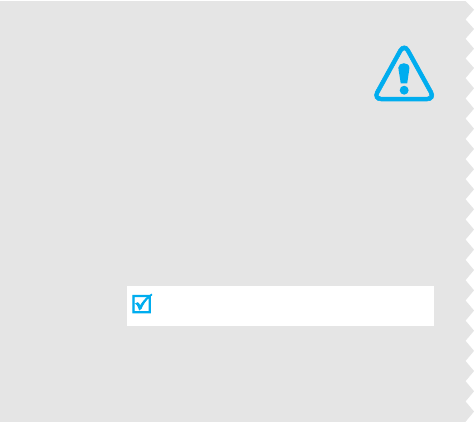
1
Important
safety
precautions
Failure to comply with the following
precautions may be dangerous or illegal.
Drive safely at all times
Do not use a hand-held phone while driving. Park
the vehicle first.
Switch off the phone when refueling
Do not use the phone at a refueling point (service
station) or near fuels or chemicals.
Switch off in an aircraft
Wireless phones can cause interference. Using
them in an aircraft is both illegal and dangerous.
Switch off the phone near all medical
equipment
Hospitals or health care facilities may be using
equipment that could be sensitive to external radio
frequency energy. Follow any regulations or rules
in force.
Interference
All wireless phones may be subject to interference,
which could affect their performance.
M620.book Page 1 Friday, December 1, 2006 12:57 PM
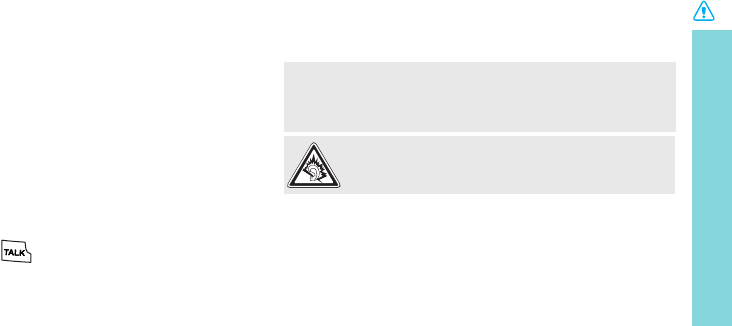
Important safety precautions
2
Be aware of special regulations
Meet any special regulations in force in any area and
always switch off your phone whenever it is forbidden
to use it, or when it may cause interference or danger.
Water resistance
Your phone is not water-resistant. Keep it dry.
Sensible use
Use only in the normal position (held to the ear). Avoid
unnecessary contact with the antenna when the phone
is switched on.
Emergency call
Key in the emergency number for your present
location, then press .
Keep your phone away from small children
Keep the phone and all its parts, including accessories,
out of the reach of small children.
Accessories and batteries
Use only Samsung-approved batteries and
accessories, such as headsets and PC data cables. Use
of any unauthorised accessories could damage you or
your phone and may be dangerous.
Qualified service
Only qualified service personnel may repair your
phone.
For more detailed safety information, see "Health and
safety information" on page 20.
• The phone could explode if the battery is replaced with an
incorrect type.
• Dispose of used batteries according to the manufacturer’s
instructions.
At very high volumes, prolonged listening to a
headset can damage your hearing.
M620.book Page 2 Friday, December 1, 2006 12:57 PM

3
Contents
Unpack 4
Make sure you have each item
Your phone 4
Keys, features, and locations
Get started 5
First steps to operating your phone
Power on or off........................................................ 6
Switch between Phone mode and
Multimedia Player mode............................................ 7
Keys and icons ........................................................ 7
Menu functions 10
All menu options listed
Solve problems 19
Help and personal needs
Health and safety information 20
M620.book Page 3 Friday, December 1, 2006 12:57 PM
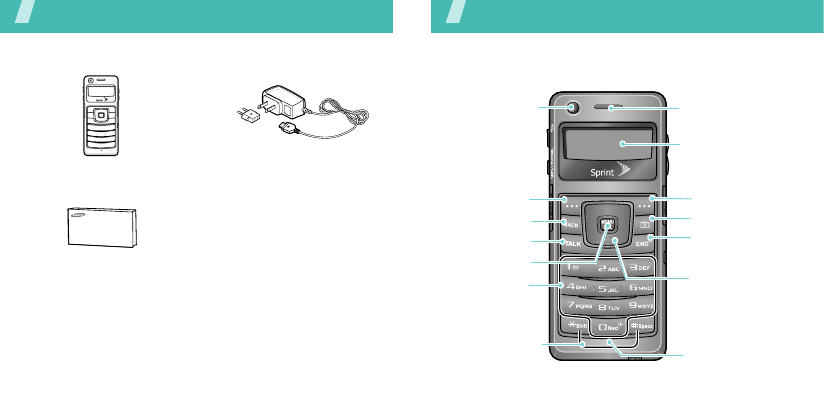
4
Unpack
Make sure you have each item
You can obtain various accessories from your local
Samsung dealer.
Your phone
Keys, features, and locations
Phone Travel Adapter
User’s Guide
• Battery Charger • Leather Case
• Car Charger/Adapter • Data Cable
• Travel Charger/Adapter
• Headset
• Portable Hands Free Kit
Special
function keys
Earpiece
Phone display
Power on/off/
Menu exit key
Microphone
Left soft key
Alphanumeric
keys
Right soft key
Navigation keys (Up/
Down/Left/Right)
Menu access/
Confirm key
Camera lens
Camera key
Delete key
Dial key
M620.book Page 4 Friday, December 1, 2006 12:57 PM
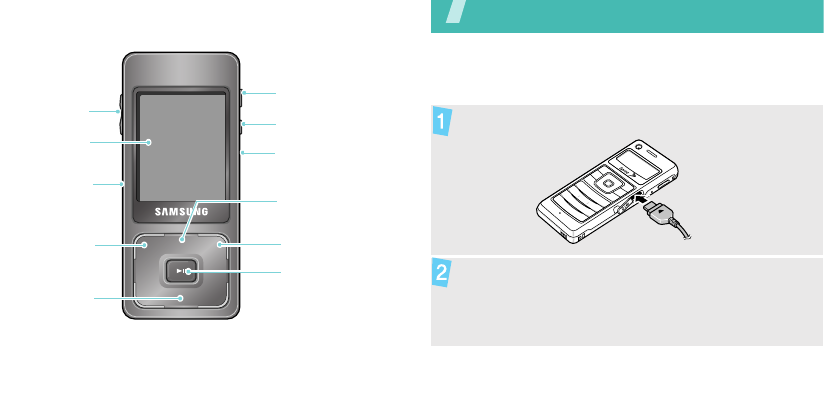
5
Get started
First steps to operating your phone
Charge the phone
Volume keys
Multimedia
player display
Right navigation/
soft key
Option key
Menu exit key
Memory card slot
Headset/
Adapter jack
Phone/Multimedia
player switch key
Left navigation/
soft key
Confirm key
Keypad lock switch
Plug the travel adapter into the phone.
Plug the adapter into a standard AC power outlet.
M620.book Page 5 Friday, December 1, 2006 12:57 PM
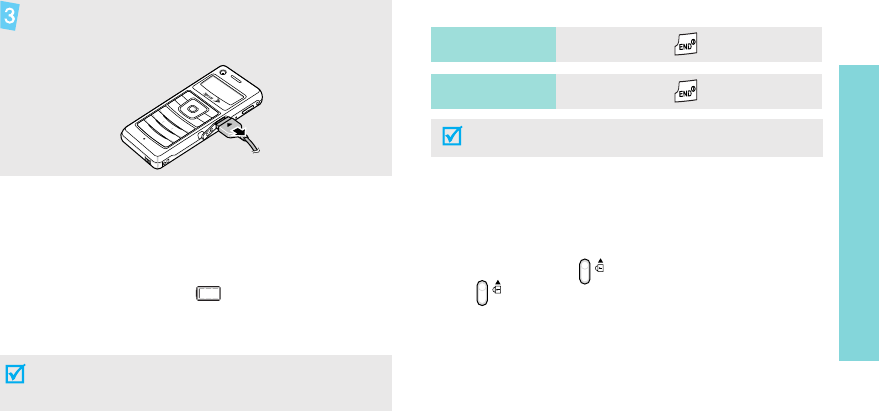
6
Get started
Low battery indicator
When the battery is low:
• a warning tone sounds,
• the battery low message displays, and
• the empty battery icon blinks.
If the battery level becomes too low, the phone
automatically turns off. Recharge your battery.
Power on or off
Keypad lock
You can lock the keypad to prevent any unwanted
phone operations from accidentally pressing any of the
keys.
In Idle mode, press up. To unlock the keypad,
press down.
When the phone is completely charged, unplug the
adapter from the power outlet and from the
phone.
Your phone’s battery is non-replaceable. When the
lifespan of the battery expires, bring the phone to a
Samsung service centre to replace the battery.
Switch on
Press and hold
.
Switch off
Press and hold
.
Do not turn on the phone when mobile phone use is
prohibited.
M620.book Page 6 Friday, December 1, 2006 12:57 PM
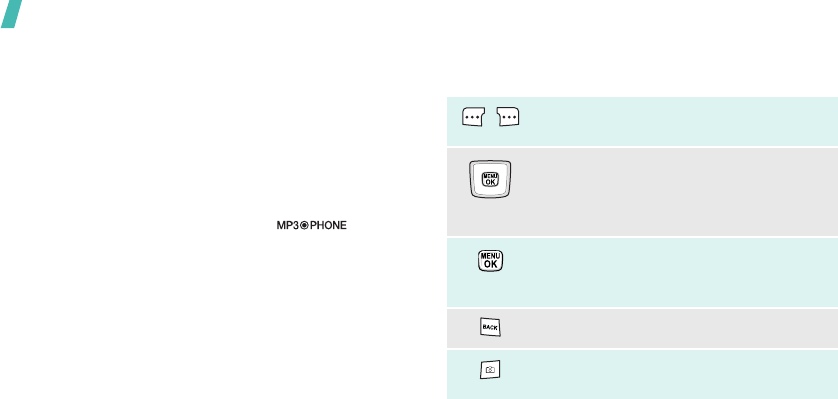
7
Get started
Switch between Phone mode and
Multimedia Player mode
Your phone provides you with entertaining multimedia
functions, as well as traditional phone functions.
When you switch on your phone, it goes into
traditional Phone mode using the small display on the
front side.
To switch the phone to Multimedia Player mode to use
multimedia player functions, press [ ]. The
larger screen on the rear side turns on.
Keys and icons
Phone keys
Perform the function indicated on the
bottom line of the display.
In Idle mode, access your favourite
menus directly.
In Menu mode, scroll through menu
options.
In Idle mode, access Menu mode.
In Menu mode, select the highlighted
menu option or confirm input.
Delete characters from the display.
In Idle mode, press and hold to turn on
the camera.
M620.book Page 7 Friday, December 1, 2006 12:57 PM
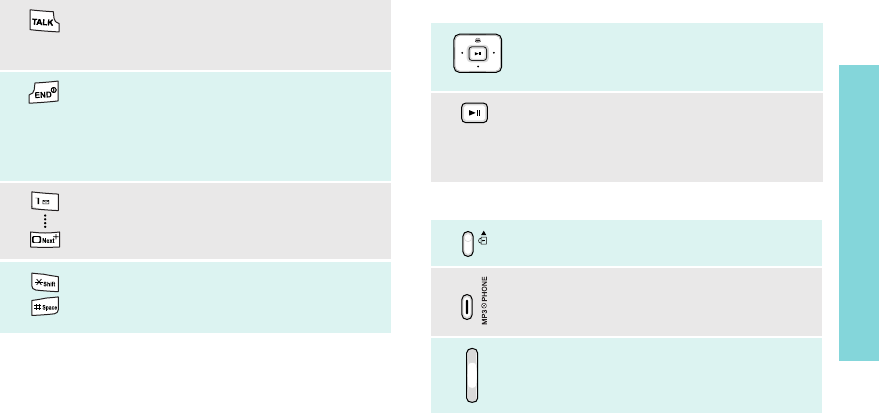
8
Get started
Multimedia player keys
Common keys
Make or answer a call.
In Idle mode, retrieve the numbers
recently dialled, missed, or received.
Press and hold to switch the phone on or
off.
End a call.
In Menu mode, cancel input and return
the phone to Idle mode.
Enter numbers, letters, and some special
characters.
Enter special characters or perform
special functions.
Scroll through items or perform a specific
function, according to your actions:
dragging, pressing, or holding.
Select the highlighted menu option or
confirm input.
Take a photo, record a video or voice
memo, or begin music playback.
Lock or unlock the keys.
Switch between Phone mode and
Multimedia Player mode.
Adjust the phone volume.
M620.book Page 8 Friday, December 1, 2006 12:57 PM

9
1 Web
1 Launch
2 Call History
1 Outgoing Calls
2 Incoming Calls
3 Missed Calls
4 Recent Calls
3 Media Player
1 Channel Listing
2 Memory Card
3 Play List
4 On Demand
1 On Demand
5 Missed Alerts
1 Missed Alerts
6 Music
1 Music
7 My Content
Games
Themes
Ringers
Screen Savers
Applications
IM & Email
Call Tones
8 Messaging
1 Send Message
2 Text Message
3 Picture Mail
4 VoiceSMS
5 IM & Email
6 Voicemail
7 Chat & Dating
8 Premium Message
9 Settings
9 Tools
1 Mass Storage
2 Voice Service
3 Voice Memo
4 Bluetooth
5 Planner
6 Memo Pad
7 World Time
8 Alarm Clock
9 Calculator
0 Set Time
* Pictures
1 Camera
2 Camcorder
3 Picture Mail
4 My Albums
5 Print
6 PictBridge Print
7 Settings and Info
Overview of menu functions
To access Menu mode, press in Idle mode.
0 Contacts
1 Find
2 Add New Entry
3 Speed Dial #s
4 Group
5 My Name Card
6 Wireless Backup
7 Services
# Settings
1 Display
2 Sounds
3 Power Vision
4 Voice Service
5 Wireless Backup
6 Security
7 Roaming
8 Launch Pad
9 Others
0 Phone
* Bluetooth
M620.book Page 9 Friday, December 1, 2006 12:57 PM

10
Menu functions
All menu options listed
Web
The Wireless Application Protocol (WAP) browser on
your phone allows you to access the wireless web.
From the wireless web, you can access up-to-date
information and a wide variety of media content, such
as games, themes, ringtones, screensavers and music
files.
Selecting this menu launches the web browser and
accesses the homepage of your service provider.
To access this menu, press in Idle mode and
select
Web
.
Launch
Use this menu to connect your phone to the network
and load the homepage of the wireless web service
provider.
Call History
Use this menu to view the calls you have dialed,
received, or missed.
To access this menu, press in Idle mode and
select
Call History
.
Outgoing Calls
This menu displays the most recent calls you have
dialed.
Incoming Calls
This menu displays the most recent calls you have
received.
Missed Calls
This menu displays the most recent calls you did not
answer.
Recent Calls
This menu displays the most recent calls dialed,
received, or missed.
M620.book Page 10 Friday, December 1, 2006 12:57 PM

11
Menu functions
Media Player
Use this menu to play music or video files from a
memory card or stream the files on a media channel.
To access this menu, press in Idle mode and
select
Media Player
.
Channel Listing
You can access music or video files on channels
supplied by your service provider and stream the files.
Memory Card
You can access music or video files stored on a
memory card
Play List
You can access music or video files from a play list you
have created.
On Demand
Use this menu to easily retrieve the most popular web
information. Using zip code,
On Demand
displays a
variety of top categories such as news, sports,
weather, money, and more, to tailored to your
preferred area.
To access this menu, press in Idle mode and
select
On Demand
.
Missed Alerts
When you are unable to acknowledge an alarm for
scheduled items or alarm alerts, or when you have
missed a call or an alert for a message, the phone
stores the alarm or alert until you confirm it.
To access this menu, press in Idle mode and
select
Missed Alerts
.
M620.book Page 11 Friday, December 1, 2006 12:57 PM

Menu functions Music
12
Music
Use this menu to access Music Store, an online music
distribution site that lets you purchase and download
music files to play on your phone.
To access this menu, press in Idle mode and
select
Music
.
My Content
The
My Content
menu allows you to access games,
themes, ringtones, screensavers, and various
applications stored in your phone’s memory. You can
also manage the contents you have downloaded from
the web.
To access this menu, press in Idle mode and
select
My Content
.
Games
Use this menu to access and download games.
Themes
Use this menu to access and download various
themes.
Ringers
Use this menu to access ringtones and sound clips you
have downloaded from the wireless web.
Screen Savers
Use this menu to access screensavers you have
downloaded from the wireless web.
Applications
Use this menu to access various applications you have
downloaded from the wireless web.
IM & Email
Use this menu to access instant messaging
applications you have downloaded.
M620.book Page 12 Friday, December 1, 2006 12:57 PM

13
Menu functions
Call Tones
Use this menu to access and download various call
tones.
Messaging
Use the
Messaging
menu to send and receive text
messages, multimedia messages, and hand written
messages.
To access this menu, press in Idle mode and
select
Massaging
.
Send Message
Use this menu to create and send messages.
Text Message
Use this menu to access messages you have received,
sent, or which have failed in sending.
Picture Mail
Use this menu to access multimedia messages you
have received, sent, or saved.
VoiceSMS
Use this menu to access voice SMS messages you
have received.
IM & Email
IM (Instant Messaging) service is a way of sending
short, simple messages that are delivered immediately
to users online at that moment. This menu provides
you with access to popular instant messaging clients.
Voicemail
Use this menu to connect to the voicemail server and
access your voicemail.
Chat & Dating
This menu provides you with access to wireless
chatting services.
M620.book Page 13 Friday, December 1, 2006 12:57 PM

Menu functions Tools
14
Premium Message
Use this menu to access premium messages including
images, videos, and audio received from your service
provider, or a third party provider. For further details
on receiving this message, contact your service
provider.
Settings
Use this menu to set up various options for using the
messaging services.
Tools
Use this menu to access Bluetooth services, keep track
of your schedule, create tasks, make memos, or set
alarms. You can also use your phone as a countdown
timer, world clock, and calculator.
To access this menu, press in Idle mode and
select
Tools
.
Mass Storage
Use this menu to connect your phone to a PC and copy
media files from/to a PC, as you would use an external
memory disk.
Voice Service
Your phone provides a set of powerful voice-enabled
features that enhance its hands-free capabilities.
Voice Memo
Use this menu to record voice memos.
Bluetooth
Use this menu to connect your phone to other
compatible devices wirelessly using Bluetooth
technology.Using Bluetooth wireless, you can connect
the phone wirelessly to a Bluetooth headset or hand-
free kit to talk hands-free.
M620.book Page 14 Friday, December 1, 2006 12:57 PM

15
Menu functions
Planner
Use this menu to keep track of your schedule, make
your task list. You can also use your phone as a
countdown timer.
Memo Pad
Use this menu to make memos of important things
you need to remember.
World Time
Use this menu to find out the current time in another
part of the world.
Alarm Clock
Use this menu to set alarms to sound at specific times.
Calculator
Use this menu to perform basic arithmetic functions,
such as addition, subtraction, multiplication, and
division.
Set Time
Use this menu to change the time and date displayed
on your phone.
Pictures
You can use the camera module embedded in your
phone to take photos and record videos.
To access this menu, press in Idle mode and
select
Pictures
.
Camera
You can take photos using the camera module
embedded in your phone.
Camcorder
You can record a video of what is displayed on the
camera screen and save it.
M620.book Page 15 Friday, December 1, 2006 12:57 PM

Menu functions Contacts
16
Picture Mail
Use this menu to access multimedia messages you
have received, sent, or saved.
My Albums
Use this menu to access your photos or video clips in
your phone’s memory or on a memory card. You can
also access your online album.
Print
Use this menu to send photos to a destination preset
by your service provider, or a photo printing shop via
Picture messaging service.
PictBridge Print
Use this menu to print images via a Pictbridge-
compatible printer.
Settings and Info
Use this menu to change the default settings for using
the camera or camcorder, or access your account or
memory information.
Contacts
You can store phone numbers with associated names
in your phone’s memory called Contacts to make it
easy for you to make a call without having to
remember the phone number.
To access this menu, press in Idle mode and
select
Contacts
.
Find
Use this menu to search for numbers in Contacts.
Add New Entry
Use this menu to add a new contact to Contacts.
M620.book Page 16 Friday, December 1, 2006 12:57 PM

17
Menu functions
Speed Dial #s
Once you have stored phone numbers in Contacts, you
can set up to 98 speed-dial entries and then dial them
easily by pressing and holding the associated one or
two number keys.
Group
Use this menu to organize your contacts in caller
groups.
My Name Card
Use this menu to create a name card and send it to
other people.
Wireless Backup
Use this menu to forward files or information on your
phone directly to a Sprint data base. The information
can be accessed easily online and synced with a
computer.
Services
Your phone is preprogrammed with contact numbers
for various services.
Settings
The
Settings
menu provides you with various setting
options to customize the phone to your preferences
and needs. You can also reset the settings to their
default status. To access this menu, press in Idle
mode and select
Settings
.
Display
Use this menu to change settings for the display and
backlight.
Sounds
Use this menu to customize various sound settings.
M620.book Page 17 Friday, December 1, 2006 12:57 PM

Menu functions Settings
18
Power Vision
Use this menu to change the settings for using Power
Vision services or update the connection profile.
Voice Service
Use this menu to customize settings for voice tools.
Wireless Backup
Use this menu to customize settings for Wireless
Backup.
Security
Use this menu to protect the phone against
unauthorized use.
Roaming
This menu provides you with options for selecting a
network.
Launch Pad
You can use the Navigation keys as shortcuts to access
specific menus directly from Idle mode. Use this menu
to assign a shortcut to a key.
Others
You can customize various phone settings.
Phone Info
Use this menu to access your phone information.
Bluetooth
Use this menu to change the Bluetooth settings.
M620.book Page 18 Friday, December 1, 2006 12:57 PM

19
Solve problems
Help and personal needs
To save the time and expense of an unnecessary
service call, perform the simple checks in this section
before contacting a service professional.
When you switch on your phone, the following
messages may appear:
“No service,” “Network failure,” or “Not done”
displays
• The network connection has been lost. You may be
in a weak signal area. Move and try again.
• You are trying to access an option for which you
have no subscription with your service provider.
Contact the service provider for further details.
You have entered a number but it was not dialed
• Be sure that you have pressed .
• Be sure that you have accessed the right cellular
network.
Your correspondent cannot reach you
• Be sure that your phone is switched on. (
pressed for more than one second.)
• Be sure that you have accessed the right cellular
network.
Your correspondent cannot hear you speaking
• Be sure that you have switched on the
microphone.
• Be sure that you are holding the phone close
enough to your mouth. The microphone is located
at the bottom of the phone.
The phone starts beeping and “Warning. low
battery” flashes on the display
• Your battery is insufficiently charged. Recharge the
battery.
The audio quality of the call is poor
• Check the signal strength indicator on the display
( ). The number of bars indicates the signal
strength from strong ( ) to weak ( ).
M620.book Page 19 Friday, December 1, 2006 12:57 PM

20
• Try moving the phone slightly or moving closer to a
window if you are in a building.
No number is dialed when you re-call a
Phonebook entry
•Use the
Find
menu to ensure the number has been
stored correctly.
• Re-store the number, if necessary.
The battery does not charge properly or the
phone sometimes turns itself off
• Wipe the charging contacts both on the phone and
on the battery with a clean soft cloth.
If the above guidelines do not help you to solve
the problem, take note of:
• The model and serial numbers of your phone
• Your warranty details
• A clear description of the problem
Then contact your local dealer or Samsung after-sales
service.
Health and safety information
Exposure to Radio Frequency (RF) Signals
Certification Information (SAR)
Your wireless phone is a radio transmitter and receiver.
It is designed and manufactured not to exceed the
exposure limits for radio frequency (RF) energy set by
the Federal Communications Commission (FCC) of the
U.S. government. These FCC exposure limits are
derived from the recommendations of two expert
organizations, the National Counsel on Radiation
Protection and Measurement (NCRP) and the Institute
of Electrical and Electronics Engineers (IEEE). In both
cases, the recommendations were developed by
scientific and engineering experts drawn from
industry, government, and academia after extensive
reviews of the scientific literature related to the
biological effects of RF energy.
M620.book Page 20 Friday, December 1, 2006 12:57 PM

21
Health and safety information
The exposure limit set by the FCC for wireless mobile
phones employs a unit of measurement known as the
Specific Absorption Rate (SAR). The SAR is a measure
of the rate of absorption of RF energy by the human
body expressed in units of watts per kilogram (W/kg).
The FCC requires wireless phones to comply with a
safety limit of 1.6 watts per kilogram (1.6 W/kg). The
FCC exposure limit incorporates a substantial margin
of safety to give additional protection to the public and
to account for any variations in measurements.
SAR tests are conducted using standard operating
positions accepted by the FCC with the phone
transmitting at its highest certified power level in all
tested frequency bands. Although the SAR is
determined at the highest certified power level, the
actual SAR level of the phone while operating can be
well below the maximum value. This is because the
phone is designed to operate at multiple power levels
so as to use only the power required to reach the
network. In general, the closer you are to a wireless
base station antenna, the lower the power output.
Before a new model phone is available for sale to the
public, it must be tested and certified to the FCC that
it does not exceed the exposure limit established by
the FCC. Tests for each model phone are performed in
positions and locations (e.g. at the ear and worn on
the body) as required by the FCC.
The highest SAR values for this model phone as
reported to the FCC are:
CDMA
• Head: 1.06 W/Kg.
• Body-worn: 0.734 W/Kg.
PCS
• Head: 1.40 W/Kg.
• Body-worn: 0.613 W/Kg.
For body worn operation, this model phone has been
tested and meets the FCC RF exposure guidelines
when used with a Samsung accessory designated for
this product or when used with an accessory that
contains no metal and that positions the handset a
minimum of 1.5 cm from the body. Non-compliance
with the above restrictions may result in violation of
FCC RF exposure guidelines.
M620.book Page 21 Friday, December 1, 2006 12:57 PM

Health and safety information
22
SAR information on this and other model phones can
be viewed on-line at www.fcc.gov/oet/fccid. This site
uses the phone FCC ID number, A3LSPHM620.
Sometimes it may be necessary to remove the battery
pack to find the number. Once you have the FCC ID
number for a particular phone, follow the instructions
on the website and it should provide values for typical
or maximum SAR for a particular phone. Additional
product specific SAR information can also be obtained
at www.fcc.gov/cgb/sar.
UL Certified Travel Adapter
The Travel Adapter for this phone has met UL 1310
safety requirements. Please adhere to the following
safety instructions per UL guidelines.
FAILURE TO FOLLOW THE INSTRUCTIONS OUTLINED
MAY LEAD TO SERIOUS PERSONAL INJURY AND
POSSIBLE PROPERTY DAMAGE.
IMPORTANT SAFETY INSTRUCTIONS - SAVE THESE
INSTRUCTIONS.
DANGER - TO REDUCE THE RISK OF FIRE OR
ELECTRIC SHOCK, CAREFULLY FOLLOW THESE
INSTRUCTIONS.
FOR CONNECTION TO A SUPPLY NOT IN THE U.S.A.,
USE AN ATTACHMENT PLUG ADAPTOR OF THE PROPER
CONFIGURATION FOR THE POWER OUTLET.
Consumer Information on Wireless Phones
The U.S. Food and Drug Administration (FDA) has
published a series of Questions and Answers for
consumers relating to radio frequency (RF) exposure
from wireless phones. The FDA publication includes
the following information:
What kinds of phones are the subject of this
update?
The term wireless phone refers here to hand-held
wireless phones with built-in antennas, often called
“cell,” “mobile,” or “PCS” phones. These types of
wireless phones can expose the user to measurable
radio frequency energy (RF) because of the short
distance between the phone and the user's head.
M620.book Page 22 Friday, December 1, 2006 12:57 PM

23
Health and safety information
These RF exposures are limited by Federal
Communications Commission safety guidelines that
were developed with the advice of FDA and other
federal health and safety agencies. When the phone is
located at greater distances from the user, the
exposure to RF is drastically lower because a person's
RF exposure decreases rapidly with increasing
distance from the source. The so-called “cordless
phones,” which have a base unit connected to the
telephone wiring in a house, typically operate at far
lower power levels, and thus produce RF exposures
well within the FCC's compliance limits.
Do wireless phones pose a health hazard?
The available scientific evidence does not show that
any health problems are associated with using
wireless phones. There is no proof, however, that
wireless phones are absolutely safe. Wireless phones
emit low levels of radio frequency energy (RF) in the
microwave range while being used. They also emit
very low levels of RF when in the stand-by mode.
Whereas high levels of RF can produce health effects
(by heating tissue), exposure to low level RF that does
not produce heating effects causes no known adverse
health effects. Many studies of low level RF exposures
have not found any biological effects. Some studies
have suggested that some biological effects may
occur, but such findings have not been confirmed by
additional research. In some cases, other researchers
have had difficulty in reproducing those studies, or in
determining the reasons for inconsistent results.
What is FDA's role concerning the safety of
wireless phones?
Under the law, FDA does not review the safety of
radiation-emitting consumer products such as wireless
phones before they can be sold, as it does with new
drugs or medical devices. However, the agency has
authority to take action if wireless phones are shown
to emit radio frequency energy (RF) at a level that is
hazardous to the user. In such a case, FDA could
require the manufacturers of wireless phones to notify
users of the health hazard and to repair, replace or
recall the phones so that the hazard no longer exists.
Although the existing scientific data do not justify FDA
regulatory actions, FDA has urged the wireless phone
M620.book Page 23 Friday, December 1, 2006 12:57 PM

Health and safety information
24
industry to take a number of steps, including the
following:
• Support needed research into possible biological
effects of RF of the type emitted by wireless
phones;
• Design wireless phones in a way that minimizes
any RF exposure to the user that is not necessary
for device function; and
• Cooperate in providing users of wireless phones
with the best possible information on possible
effects of wireless phone use on human health.
FDA belongs to an interagency working group of the
federal agencies that have responsibility for different
aspects of RF safety to ensure coordinated efforts at
the federal level. The following agencies belong to this
working group:
• National Institute for Occupational Safety and
Health
• Environmental Protection Agency
• Federal Communications Commission
• Occupational Safety and Health Administration
• National Telecommunications and Information
Administration
The National Institutes of Health participates in some
interagency working group activities, as well.
FDA shares regulatory responsibilities for wireless
phones with the Federal Communications Commission
(FCC). All phones that are sold in the United States
must comply with FCC safety guidelines that limit RF
exposure. FCC relies on FDA and other health agencies
for safety questions about wireless phones.
FCC also regulates the base stations that the wireless
phone networks rely upon. While these base stations
operate at higher power than do the wireless phones
themselves, the RF exposures that people get from
these base stations are typically thousands of times
lower than those they can get from wireless phones.
Base stations are thus not the primary subject of the
safety questions discussed in this document.
M620.book Page 24 Friday, December 1, 2006 12:57 PM

25
Health and safety information
What are the results of the research done
already?
The research done thus far has produced conflicting
results, and many studies have suffered from flaws in
their research methods. Animal experiments
investigating the effects of radio frequency energy
(RF) exposures characteristic of wireless phones have
yielded conflicting results that often cannot be
repeated in other laboratories. A few animal studies,
however, have suggested that low levels of RF could
accelerate the development of cancer in laboratory
animals. However, many of the studies that showed
increased tumor development used animals that had
been genetically engineered or treated with cancer-
causing chemicals so as to be pre-disposed to develop
cancer in absence of RF exposure. Other studies
exposed the animals to RF for up to 22 hours per day.
These conditions are not similar to the conditions
under which people use wireless phones, so we don't
know with certainty what the results of such studies
mean for human health.
Three large epidemiology studies have been published
since December 2000. Between them, the studies
investigated any possible association between the use
of wireless phones and primary brain cancer, glioma,
meningioma, or acoustic neuroma, tumors of the brain
or salivary gland, leukemia, or other cancers. None of
the studies demonstrated the existence of any harmful
health effects from wireless phones RF exposures.
However, none of the studies can answer questions
about long-term exposures, since the average period
of phone use in these studies was around three years.
What research is needed to decide whether
RF exposure from wireless phones poses a
health risk?
A combination of laboratory studies and
epidemiological studies of people actually using
wireless phones would provide some of the data that
are needed. Lifetime animal exposure studies could be
completed in a few years. However, very large
numbers of animals would be needed to provide
reliable proof of a cancer promoting effect if one
M620.book Page 25 Friday, December 1, 2006 12:57 PM

Health and safety information
26
exists. Epidemiological studies can provide data that is
directly applicable to human populations, but ten or
more years' follow-up may be needed to provide
answers about some health effects, such as cancer.
This is because the interval between the time of
exposure to a cancer-causing agent and the time
tumors develop - if they do - may be many, many
years. The interpretation of epidemiological studies is
hampered by difficulties in measuring actual RF
exposure during day-to-day use of wireless phones.
Many factors affect this measurement, such as the
angle at which the phone is held, or which model of
phone is used.
What is FDA doing to find out more about the
possible health effects of wireless phone RF?
FDA is working with the U.S. National Toxicology
Program and with groups of investigators around the
world to ensure that high priority animal studies are
conducted to address important questions about the
effects of exposure to radio frequency energy (RF).
FDA has been a leading participant in the World Health
Organization international Electromagnetic Fields
(EMF) Project since its inception in 1996. An influential
result of this work has been the development of a
detailed agenda of research needs that has driven the
establishment of new research programs around the
world. The Project has also helped develop a series of
public information documents on EMF issues.
FDA and Cellular Telecommunications & Internet
Association (CTIA) have a formal Cooperative
Research and Development Agreement (CRADA) to do
research on wireless phone safety. FDA provides the
scientific oversight, obtaining input from experts in
government, industry, and academic organizations.
CTIA-funded research is conducted through contracts
to independent investigators. The initial research will
include both laboratory studies and studies of wireless
phone users. The CRADA will also include a broad
assessment of additional research needs in the
context of the latest research developments around
the world.
M620.book Page 26 Friday, December 1, 2006 12:57 PM

27
Health and safety information
What steps can I take to reduce my exposure
to radio frequency energy from my wireless
phone?
If there is a risk from these products - and at this
point we do not know that there is - it is probably very
small. But if you are concerned about avoiding even
potential risks, you can take a few simple steps to
minimize your exposure to radio frequency energy
(RF). Since time is a key factor in how much exposure
a person receives, reducing the amount of time spent
using a wireless phone will reduce RF exposure.
• “If you must conduct extended conversations by
wireless phone every day, you could place more
distance between your body and the source of the
RF, since the exposure level drops off dramatically
with distance. For example, you could use a
headset and carry the wireless phone away from
your body or use a wireless phone connected to a
remote antenna.
Again, the scientific data do not demonstrate that
wireless phones are harmful. But if you are concerned
about the RF exposure from these products, you can
use measures like those described above to reduce
your RF exposure from wireless phone use.
What about children using wireless phones?
The scientific evidence does not show a danger to
users of wireless phones, including children and
teenagers. If you want to take steps to lower exposure
to radio frequency energy (RF), the measures
described above would apply to children and
teenagers using wireless phones. Reducing the time of
wireless phone use and increasing the distance
between the user and the RF source will reduce RF
exposure.
Some groups sponsored by other national
governments have advised that children be
discouraged from using wireless phones at all. For
example, the government in the United Kingdom
distributed leaflets containing such a recommendation
in December 2000. They noted that no evidence exists
that using a wireless phone causes brain tumors or
M620.book Page 27 Friday, December 1, 2006 12:57 PM

Health and safety information
28
other ill effects. Their recommendation to limit
wireless phone use by children was strictly
precautionary; it was not based on scientific evidence
that any health hazard exists.
Do hands-free kits for wireless phones reduce
risks from exposure to RF emissions?
Since there are no known risks from exposure to RF
emissions from wireless phones, there is no reason to
believe that hands-free kits reduce risks. Hands-free
kits can be used with wireless phones for convenience
and comfort. These systems reduce the absorption of
RF energy in the head because the phone, which is the
source of the RF emissions, will not be placed against
the head. On the other hand, if the phone is mounted
against the waist or other part of the body during use,
then that part of the body will absorb more RF energy.
Wireless phones marketed in the U.S. are required to
meet safety requirements regardless of whether they
are used against the head or against the body. Either
configuration should result in compliance with the
safety limit.
Do wireless phone accessories that claim to
shield the head from RF radiation work?
Since there are no known risks from exposure to RF
emissions from wireless phones, there is no reason to
believe that accessories that claim to shield the head
from those emissions reduce risks. Some products
that claim to shield the user from RF absorption use
special phone cases, while others involve nothing
more than a metallic accessory attached to the phone.
Studies have shown that these products generally do
not work as advertised. Unlike “hand-free” kits, these
so-called “shields” may interfere with proper operation
of the phone. The phone may be forced to boost its
power to compensate, leading to an increase in RF
absorption. In February 2002, the Federal trade
Commission (FTC) charged two companies that sold
devices that claimed to protect wireless phone users
from radiation with making false and unsubstantiated
claims. According to FTC, these defendants lacked a
reasonable basis to substantiate their claim.
M620.book Page 28 Friday, December 1, 2006 12:57 PM

29
Health and safety information
What about wireless phone interference with
medical equipment?
Radio frequency energy (RF) from wireless phones can
interact with some electronic devices. For this reason,
FDA helped develop a detailed test method to measure
electromagnetic interference (EMI) of implanted
cardiac pacemakers and defibrillators from wireless
telephones. This test method is now part of a standard
sponsored by the Association for the Advancement of
Medical instrumentation (AAMI). The final draft, a joint
effort by FDA, medical device manufacturers, and
many other groups, was completed in late 2000. This
standard will allow manufacturers to ensure that
cardiac pacemakers and defibrillators are safe from
wireless phone EMI. FDA has tested wireless phones
and helped develop a voluntary standard sponsored by
the Institute of Electrical and Electronic Engineers
(IEEE). This standard specifies test methods and
performance requirements for hearing aids and
wireless phones so that no interference occurs when a
person uses a compatible phone and a compatible
hearing aid at the same time. This standard was
approved by the IEEE in 2000.
FDA continues to monitor the use of wireless phones
for possible interactions with other medical devices.
Should harmful interference be found to occur, FDA
will conduct testing to assess the interference and
work to resolve the problem.
Additional information on the safety of RF exposures
from various sources can be obtained from the
following organizations:
• FCC RF Safety Program:
http://www.fcc.gov/oet/rfsafety/
• Environmental Protection Agency (EPA):
http://www.epa.gov/radiation/
• Occupational Safety and Health Administration's
(OSHA):
http://www.osha.gov/SLTC/
radiofrequencyradiation/index.html
• National institute for Occupational Safety and
Health (NIOSH):
M620.book Page 29 Friday, December 1, 2006 12:57 PM

Health and safety information
30
http://www.cdc.gov/niosh/emfpg.html
• World health Organization (WHO):
http://www.who.int/peh-emf/
• International Commission on Non-Ionizing
Radiation Protection:
http://www.icnirp.de
• National Radiation Protection Board (UK):
http://www.nrpb.org.uk
• Updated 4/3/2002: US food and Drug
Administration
http://www.fda.gov/cellphones
Road Safety
Your wireless phone gives you the powerful ability to
communicate by voice, almost anywhere, anytime.
But an important responsibility accompanies the
benefits of wireless phones, one that every user must
uphold.
When driving a car, driving is your first responsibility.
When using your wireless phone behind the wheel of a
car, practice good common sense and remember the
following tips:
1. Get to know your wireless phone and its features,
such as speed dial and redial. If available, these
features help you to place your call without taking
your attention off the road.
2. When available, use a hands-free device. If
possible, add an additional layer of convenience
and safety to your wireless phone with one of the
many hands free accessories available today.
3. Position your wireless phone within easy reach. Be
able to access your wireless phone without
removing your eyes from the road. If you get an
incoming call at an inconvenient time, let your
voice mail answer it for you.
4. Let the person you are speaking with know you are
driving; if necessary, suspend the call in heavy
traffic or hazardous weather conditions. Rain,
M620.book Page 30 Friday, December 1, 2006 12:57 PM

31
Health and safety information
sleet, snow, ice and even heavy traffic can be
hazardous.
5. Do not take notes or look up phone numbers while
driving. Jotting down a “to do” list or flipping
through your address book takes attention away
from your primary responsibility, driving safely.
6. Dial sensibly and assess the traffic; if possible,
place calls when you are not moving or before
pulling into traffic. Try to plan calls when your car
will be stationary. If you need to make a call while
moving, dial only a few numbers, check the road
and your mirrors, then continue.
7. Do not engage in stressful or emotional
conversations that may be distracting. Make
people you are talking with aware you are driving
and suspend conversations that have the potential
to divert your attention from the road.
8. Use your wireless phone to call for help. Dial 9-1-1
or other local emergency number in the case of
fire, traffic accident or medical emergencies.
Remember, it is a free call on your wireless phone!
9. Use your wireless phone to help others in
emergencies. If you see an auto accident, crime in
progress or other serious emergency where lives
are in danger, call 9-1-1 or other local emergency
number, as you would want others to do for you.
10. Call roadside assistance or a special non-
emergency wireless assistance number when
necessary. If you see a broken-down vehicle
posing no serious hazard, a broken traffic signal, a
minor traffic accident where no one appears
injured, or a vehicle you know to be stolen, call
roadside assistance or other special non-
emergency number.
“The wireless industry reminds you to use your
phone safely when driving.”
For more information, please call 1-888-901-SAFE, or
visit our web-site www.wow-com.com
Provided by the Cellular Telecommunications &
Internet Association
M620.book Page 31 Friday, December 1, 2006 12:57 PM

Health and safety information
32
Operating Environment
Remember to follow any special regulations in force in
any area and always switch your phone off whenever it
is forbidden to use it, or when it may cause
interference or danger. When connecting the phone or
any accessory to another device, read its user's guide
for detailed safety instructions. Do not connect
incompatible products.
As with other mobile radio transmitting equipment,
users are advised that for the satisfactory operation of
the equipment and for the safety of personnel, it is
recommended that the equipment should only be used
in the normal operating position (held to your ear with
the antenna pointing over your shoulder).
Using Your Phone Near Other Electronic
Devices
Most modern electronic equipment is shielded from
radio frequency (RF) signals. However, certain
electronic equipment may not be shielded against the
RF signals from your wireless phone. Consult the
manufacturer to discuss alternatives.
Pacemakers
Pacemaker manufacturers recommend that a
minimum distance of 15 cm (6 inches) be maintained
between a wireless phone and a pacemaker to avoid
potential interference with the pacemaker.
These recommendations are consistent with the
independent research and recommendations of
Wireless Technology Research.
Persons with pacemakers:
• should always keep the phone more than 15 cm
(6 inches) from their pacemaker when the phone is
switched on.
• should not carry the phone in a breast pocket.
• should use the ear opposite the pacemaker to
minimize potential interference.
If you have any reason to suspect that interference is
taking place, switch your phone off immediately.
Hearing Aids
Some digital wireless phones may interfere with some
hearing aids. In the event of such interference, you
M620.book Page 32 Friday, December 1, 2006 12:57 PM

33
Health and safety information
may wish to consult your hearing aid manufacturer to
discuss alternatives.
Other Medical Devices
If you use any other personal medical devices, consult
the manufacturer of your device to determine if it is
adequately shielded from external RF energy. Your
physician may be able to assist you in obtaining this
information. Switch your phone off in health care
facilities when any regulations posted in these areas
instruct you to do so. Hospitals or health care facilities
may be using equipment that could be sensitive to
external RF energy.
Vehicles
RF signals may affect improperly installed or
inadequately shielded electronic systems in motor
vehicles. Check with the manufacturer or its
representative regarding your vehicle. You should also
consult the manufacturer of any equipment that has
been added to your vehicle.
Posted Facilities
Switch your phone off in any facility where posted
notices require you to do so.
Potentially Explosive Environments
Switch your phone off when in any area with a
potentially explosive atmosphere and obey all signs
and instructions. Sparks in such areas could cause an
explosion or fire resulting in bodily injury or even
death.
Users are advised to switch the phone off while at a
refueling point (service station). Users are reminded of
the need to observe restrictions on the use of radio
equipment in fuel depots (fuel storage and distribution
areas), chemical plants or where blasting operations
are in progress.
Areas with a potentially explosive atmosphere are
often but not always clearly marked. They include
below deck on boats, chemical transfer or storage
facilities, vehicles using liquefied petroleum gas (such
as propane or butane), areas where the air contains
chemicals or particles, such as grain, dust or metal
M620.book Page 33 Friday, December 1, 2006 12:57 PM

Health and safety information
34
powders, and any other area where you would
normally be advised to turn off your vehicle engine.
Emergency Calls
This phone, like any wireless phone, operates using
radio signals, wireless and landline networks as well as
user programmed functions, which cannot guarantee
connection in all conditions. Therefore, you should
never rely solely on any wireless phone for essential
communications (medical emergencies, for example).
Remember, to make or receive any calls the phone
must be switched on and in a service area with
adequate signal strength. Emergency calls may not be
possible on all wireless phone networks or when
certain network services and/or phone features are in
use. Check with local service providers.
To make an emergency call:
1. If the phone is not on, switch it on.
2. Key in the emergency number for your present
location (for example, 911 or other official
emergency number). Emergency numbers vary by
location.
3. Press .
If certain features are in use (call barring, for
example), you may first need to deactivate those
features before you can make an emergency call.
Consult this document and your local cellular service
provider.
When making an emergency call, remember to give all
the necessary information as accurately as possible.
Remember that your phone may be the only means of
communication at the scene of an accident; do not cut
off the call until given permission to do so.
Restricting Children's access to your Phone
Your phone is not a toy. Children should not be allowed
to play with it because they could hurt themselves and
others, damage the phone or make calls that increase
your phone bill.
M620.book Page 34 Friday, December 1, 2006 12:57 PM

35
Health and safety information
FCC Notice and Cautions
FCC Notice
The phone may cause TV or radio interference if
used in close proximity to receiving equipment. The
FCC can require you to stop using the phone if such
interference cannot be eliminated.
Vehicles using liquefied petroleum gas (such as propane or
• This device complies with Part 15 of the FCC
Rules. Operation is subject to the following two
conditions: (1) this device may not cause harmful
interference, and (2) this device must accept any
interference received, including interference that
may cause undesired operation.
• This equipment has been tested and found to
comply with the limits for a Class B digital device,
pursuant to part 15 of the FCC Rules. These limits
are designed to provide reasonable protection
against harmful interference in a residential
installation.This equipment generates, uses and
can radiate radio frequency energy and,if not
installed and used in accordance with the instruc-
tions, may cause harmful interference to
radio communications.
However, there is no guarantee that interference
will not occur in a particular installation. If this
equipment does cause harmful interference to radio
or television reception, which can be determined by
turning the equipment off and on, the user is
encouraged to try to correct the interference by one
or more of the following measures:
-Reorient or relocate the receiving antenna.
-Increase the separation between the equipment
and receiver.
-Connect the equipment into an outlet on a circuit
different from that to which the receiver is con-
nected.
-Consult the dealer or an experienced radio/TV
technician for help
M620.book Page 35 Friday, December 1, 2006 12:57 PM

Health and safety information
36
butane) must comply with the National Fire Protection
Standard (NFPA-58). For a copy of this standard, contact
the National Fire Protection Association, One Battery march
Park, Quincy, MA 02269, Attn: Publication Sales Division.
Cautions
Changes or modifications made in the radio phone, not
expressly approved by Samsung, will void the user’s authority
to operate the equipment.
Only use approved batteries, antennas andchargers.
The use of any unauthorized accessories may be dangerous
and void the phone warranty if said accessories cause dam-
age or a defect to the phone.
Although your phone is quite sturdy, it is a complex piece of
equipment and can be broken. Avoid dropping, hitting,
bending or sitting on it.
Other Important Safety Information
• Only qualified personnel should service the phone
or install the phone in a vehicle. Faulty installation
or service may be dangerous and may invalidate
any warranty applicable to the device.
• Check regularly that all wireless phone equipment
in your vehicle is mounted and operating properly.
• Do not store or carry flammable liquids, gases or
explosive materials in the same compartment as
the phone, its parts or accessories.
• For vehicles equipped with an air bag, remember
that an air bag inflates with great force. Do not
place objects, including both installed or portable
wireless equipment in the area over the air bag or
in the air bag deployment area. If wireless
equipment is improperly installed and the air bag
inflates, serious injury could result.
• Switch your phone off before boarding an aircraft.
The use of wireless phone in aircraft is illegal and
may be dangerous to the aircraft's operation.
• Failure to observe these instructions may lead to
the suspension or denial of telephone services to
the offender, or legal action, or both.
M620.book Page 36 Friday, December 1, 2006 12:57 PM

37
Health and safety information
Product Performance
Getting the Most Out of Your Signal Reception
The quality of each call you make or receive depends
on the signal strength in your area. Your phone
informs you of the current signal strength by
displaying a number of bars next to the signal strength
icon. The more bars displayed, the stronger the signal.
If you're inside a building, being near a window may
give you better reception.
Understanding the Power Save Feature
If your phone is unable to find a signal after 15
minutes of searching, a Power Save feature is
automatically activated. If your phone is active, it
periodically rechecks service availability or you can
check it yourself by pressing any key.
Anytime the Power Save feature is activated, a
message displays on the screen. When a signal is
found, your phone returns to standby mode.
Understanding How Your Phone Operates
Your phone is basically a radio transmitter and
receiver. When it's turned on, it receives and transmits
radio frequency (RF) signals. When you use your
phone, the system handling your call controls the
power level. This power can range from 0.006 watts to
0.2 watts in digital mode.
Maintaining Your Phone's Peak Performance
For the best care of your phone, only authorized
personnel should service your phone and accessories.
Faulty service may void the warranty.
There are several simple guidelines to operating your
phone properly and maintaining safe, satisfactory
service.
• Hold the phone with the antenna raised, fully-
extended and over your shoulder.
• Try not to hold, bend or twist the phone's antenna.
• Don't use the phone if the antenna is damaged.
• Speak directly into the phone's receiver.
M620.book Page 37 Friday, December 1, 2006 12:57 PM

Health and safety information
38
• Avoid exposing your phone and accessories to rain
or liquid spills. If your phone does get wet,
immediately turn the power off and remove the
battery. If it is inoperable, call Customer Care for
service.
Availability of Various Features/Ring
Tones
Many services and features are network dependent
and may require additional subscription and/or usage
charges. Not all features are available for purchase or
use in all areas. Downloadable Ring Tones may be
available at an additional cost. Other conditions and
restrictions may apply. See your service provider for
additional information.
Battery Standby and Talk Time
Standby and talk times will vary depending on phone
usage patterns and conditions. Battery power
consumption depends on factors such as network
configuration, signal strength, operating temperature,
features selected, frequency of calls, and voice, data,
and other application usage patterns.
Battery Precautions
• Never use any charger or battery that is damaged
in any way.
• Use the battery only for its intended purpose.
• If you use the phone near the network's base
station, it uses less power; talk and standby time
are greatly affected by the signal strength on the
cellular network and the parameters set by the
network operator.
• Battery charging time depends on the remaining
battery charge and the type of battery and charger
used. The battery can be charged and discharged
hundreds of times, but it will gradually wear out.
When the operation time (talk time and standby
time) is noticeably shorter than normal, it is time
to buy a new battery.
• If left unused, a fully charged battery will
discharge itself over time.
M620.book Page 38 Friday, December 1, 2006 12:57 PM

39
Health and safety information
• Use only Samsung-approved batteries and
recharge your battery only with Samsung-
approved chargers. When a charger is not in use,
disconnect it from the power source. Do not leave
the battery connected to a charger for more than a
week, since overcharging may shorten its life.
• Extreme temperatures will affect the charging
capacity of your battery: it may require cooling or
warming first.
• Do not leave the battery in hot or cold places, such
as in a car in summer or winter conditions, as you
will reduce the capacity and lifetime of the battery.
Always try to keep the battery at room
temperature. A phone with a hot or cold battery
may temporarily not work, even when the battery
is fully charged. Li-ion batteries are particularly
affected by temperatures below 0 °C (32 °F).
• Do not short-circuit the battery. Accidental short-
circuiting can occur when a metallic object (coin,
clip or pen) causes a direct connection between the
+ and - terminals of the battery (metal strips on
the battery), for example when you carry a spare
battery in a pocket or bag. Short-circuiting the
terminals may damage the battery or the object
causing the short-circuiting.
• Dispose of used batteries in accordance with local
regulations. In some areas, the disposal of
batteries in household or business trash may be
prohibited. For safe disposal options for Li-Ion
batteries, contact your nearest Samsung
authorized service center. Always recycle. Do not
dispose of batteries in a fire.
Care and Maintenance
Your phone is a product of superior design and
craftsmanship and should be treated with care. The
suggestions below will help you fulfill any warranty
obligations and allow you to enjoy this product for
many years.
• Keep the phone and all its parts and accessories
out of the reach of small children.
M620.book Page 39 Friday, December 1, 2006 12:57 PM

Health and safety information
40
• Keep the phone dry. Precipitation, humidity and
liquids contain minerals that will corrode electronic
circuits.
• Do not use the phone with a wet hand. Doing so
may cause an electric shock to you or damage to
the phone.
• Do not use or store the phone in dusty, dirty areas,
as its moving parts may be damaged.
• Do not store the phone in hot areas. High
temperatures can shorten the life of electronic
devices, damage batteries, and warp or melt
certain plastics.
• Do not store the phone in cold areas. When the
phone warms up to its normal operating
temperature, moisture can form inside the phone,
which may damage the phone's electronic circuit
boards.
• Do not drop, knock or shake the phone. Rough
handling can break internal circuit boards.
• Do not use harsh chemicals, cleaning solvents or
strong detergents to clean the phone. Wipe it with
a soft cloth.
• Do not paint the phone. Paint can clog the device's
moving parts and prevent proper operation.
• Do not put the phone in or on heating devices,
such as a microwave oven, a stove or a radiator.
The phone may explode when overheated.
• When the phone or battery gets wet, the label
indicating water damage inside the phone changes
color. In this case, phone repairs are no longer
guaranteed by the manufacturer's warranty, even
if the warranty for your phone has not expired.
• If your phone has a flash or light, do not use it too
close to the eyes of people or animals. This may
cause damage to their eyes.
M620.book Page 40 Friday, December 1, 2006 12:57 PM

41
Health and safety information
• Use only the supplied or an approved replacement
antenna. Unauthorized antennas or modified
accessories may damage the phone and violate
regulations governing radio devices.
• If the phone, battery, charger or any accessory is
not working properly, take it to your nearest
qualified service facility. The personnel there will
assist you, and if necessary, arrange for service.
M620.book Page 41 Friday, December 1, 2006 12:57 PM

GH68-08136A
Hearing Aid Compatibility with Mobile Phones
When some mobile phones are used near some hearing devices (hearing aids and
cochlear implants), users may detect a buzzing, humming, or whining noise. Some
hearing devices are more immune than others to this interference noise, and phones
also vary in the amount of interference they generate.
The wireless telephone industry has developed ratings for some of their mobile
phones, to assist hearing device users in finding phones that may be compatible
with their hearing devices. Not all phones have been rated. Phones that are rated
have the rating on their box or a label on the box.
The ratings are not guarantees. Results will vary depending on the user’s hearing
device and hearing loss. If your hearing device happens to be vulnerable to interfer-
ence, you may not be able to use a rated phone successfully. Trying out the phone
with your hearing device is the best way to evaluate it for your personal needs.
M-Ratings: Phones rated M3 or M4 meet FCC requirements and are likely to gener-
ate less interference to hearing devices than phones that are not labeled. M4 is the
better/higher of the two ratings.
T-Ratings: Phones rated T3 or T4 meet FCC requirements and are likely to be more
usable with a hearing device’s telecoil (“T Switch” or “Telephone Switch”) than
unrated phones. T4 is the better/higher of the two ratings. (Note that not all hearing
devices have telecoils in them.)
Hearing devices may also be measured for immunity to this type of interference. Your
hearing device manufacturer or hearing health professional may help you find results
for your hearing device. The more immune your hearing aid is, the less likely you are
to experience interference noise from mobile phones.